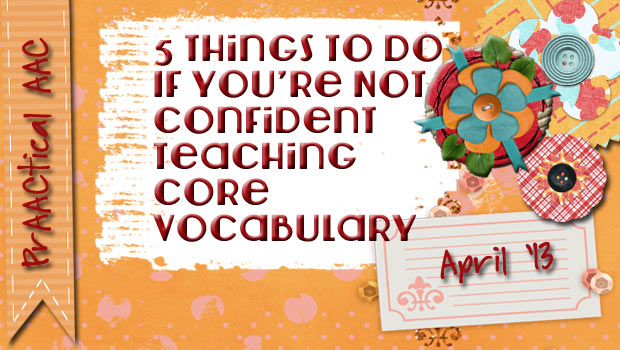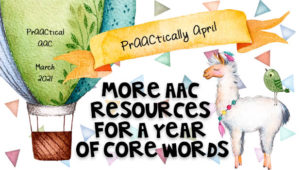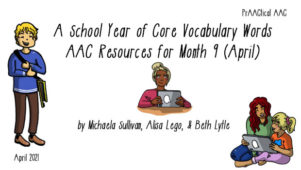5 Things to Do If You’re Not Confident Teaching Core Vocabulary

New to teaching core vocabulary in AAC? On board with the concept? Know that it’s important but find it a little intimidating to teach? Welcome to the club! Actually, it’s quite a big club but you wouldn’t know it because lots of members are still closeted. That’s okay – no one here is going to ‘out’ you. But if you want to move forward in your AAC teaching journey, here are some things to try.
-
Breathe and forgive yourself: It’s easy to feel like everyone else knows this but you. Not true. We tend to beat ourselves up for not being out ahead of the curve, but you know what? It’s not worth it. We’re all a work in progress, so let it go and just start where you are. As one of our favorite eminent scholars** has repeatedly said, “When you know better, you do better.”
-
Get your own copy of the learner’s AAC display: If it’s a high tech device or AAC app, print the screens. Or if that’s not on the radar for the moment, recreate it using Boardmaker, Custom Boards, The Grid, Microsoft Word, or whatever else you already have, know, and use. If you’re working with learners who use static display SGDs, communication books, or language boards, print yourself a copy. While you’re at it, print an extra one. Bet the family, teacher, or aide would appreciate having that.
-
Give it a try: Take your copy of the display and start pointing to some of the core words whenever you talk to the AAC learner. If it’s a complex display and you feel overwhelmed, don’t worry about it. Pick 2-3 words to highlight when you speak and ignore the rest for now. You don’t have to be perfect, but stretch yourself to use some of these whenever you interact with the person learning AAC. After a few days of pointing to “I” or “you” or “it” when you talk, it’ll start to feel more natural. Once it does, stretch yourself a little more and start pointing to 2-3 more words when you talk. No pressure on the AAC learner to look/watch. Just use it yourself when you talk to him/her and you’ll get more fluent as you do.
-
Pick one core word for explicit teaching: Look at what the AAC learner has been using and pick a word that he/she doesn’t yet use. Think about things that you can do to make the meaning come alive for the learner. If you are supporting someone at the very beginning stages of symbolic communication, try to make the activities vivid and concrete. It could be as simple as a tickle routine where we ‘stop’ and the ‘go’ (if those were the target words). You’ll need to do a lot of different activities, and give the learner a lot of opportunities to say the target word. There are some more teaching ideas in this post.
-
Spread the word: In most situations, we SLPs don’t have enough time with the AAC learner to make a real difference. (Shh! That’s our little secret.) To make progress, we have to help others get involved. Share the news of the target word(s) with your client’s communication partners so that they can also model those words and elicit them from the learner. I’m smiling as I write this with the fond memory of one little guy we worked with. We used to print out vocabulary stickers and put them on his t-shirt. “My word is ___. Ask me to say it.” Poor kid had people bugging him all day long. But, he sure learned those words!
We’re all in this together, so if you have ideas for ways to get more involved in core language teaching, please share. We’re always learning.
**Oprah Winfrey.
Filed under: PrAACtical Thinking
Tagged With: core language, core vocabulary, five things, vocabulary instruction
This post was written by Carole Zangari





2 Comments
LOVE. THIS. POST.!!!!
Thanks, Teresa! We’ll get there…little by little.